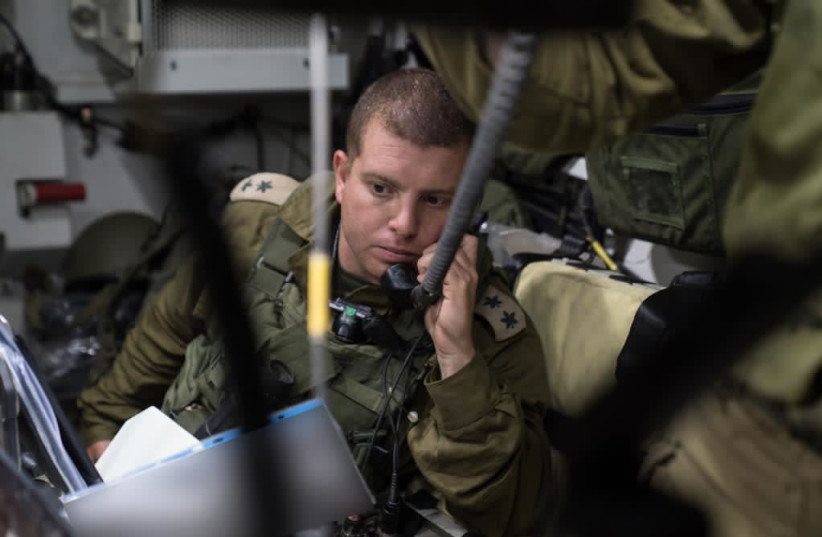Troops from the 71st armored battalion took part in the destruction of a Syrian army post in May. “We won’t allow them to operate like that,” said the battalion commander.
Troops from the 71rst armored battalion took part in the destruction of a forward post belonging to the Syrian Arab Army in May. (photo credit: IDF SPOKESPERSON’S UNIT)
Despite the calm on Israel’s northern border, the IDF remains vigilant and prepared for any violation of sovereignty by the Syrian army and by Hezbollah.
The IDF has struck several Syrian outposts in the Golan Heights since May, all of them built in the demilitarized zone.
According to Lt.-Col. Idan Nir, commander of the 71st armored battalion whose troops destroyed the post, “they wanted to test us and built it to see what we would do. But the moment they violate the agreement and our sovereignty we will act to destroy it.”
The post, Nir said, was to collect intelligence on the IDF and troop movement. It was destroyed late at night by explosives placed by troops under Nir’s command, infantry troops, and Oketz forces.
The decision to use ground forces instead of targeting the post from the air was deliberate, Nir said.
“We chose the time and method,” he said. “We sent a message that such moves won’t be tolerated. We will not allow any violations of our sovereignty by Syria.”
According to the officer, the Syrians only returned once to the site and have not rebuilt the post. And should they rebuild it, or build any others in Israeli territory, “we will act again. We have a strong army that remains alert. The ground forces are always ready and able to get anywhere, whenever they are needed,” Nir asserted.
Israel captured the Golan Heights, some 1,200 square kilometers, from Syria during the Six-Day War in 1967 and unilaterally annexed it in 1981. Under the 1974 ceasefire accord signed following the Yom Kippur War, the previous year established a buffer zone between the two enemy countries. It was patrolled by UN troops until peacekeepers were abducted by Syrian rebels in 2014.
Syrian troops recaptured southern Syria seven years after losing the area to rebel groups and returned to its positions along with Hezbollah operatives. Both UN peacekeepers and Russian military police have been deployed along the Golan Heights border.
Nevertheless, in the past two years, Iran has increased its influence in the Syrian army by training senior commanders and helping in force buildup. Hezbollah has also increased its presence on the Golan including near the demilitarized buffer zone.
In early June, the IDF struck a Syrian outpost near the city of Quientra, marking the first strike on the northern border after Prime Minister Naftali Bennett took office.
The post, some 150 meters from the border, was affiliated with the Syrian army’s 90th Brigade and First Corps had been frequented by Hezbollah officials and used as a reconnaissance post against IDF forces.
According to Syrian opposition reports, it was destroyed by tank fire.
While the IDF does not respond to most foreign reports, it has admitted to carrying out hundreds of airstrikes as part of its “war-between-wars” (known in Hebrew as MABAM) campaign to prevent the transfer of advanced weapons to Hezbollah in Lebanon and the entrenchment of Iranian forces in Syria, where they could easily act against Israel.
Although Israel usually refrains from targeting terror operatives to try to avoid subsequent retaliation, some strikes ascribed to the IDF have killed several Hezbollah operatives in southern Syria on the Golan, where the group has been trying to establish a permanent military presence as part of its Golan Project.
But according to a December report by the ALMA Research and Education Center, Hezbollah’s presence in southern Syria is much larger than previously revealed, with some 58 sites in the southern Syrian provinces of Quneitra and Daraa, where the terror group’s Southern Command and Golan Project have been deployed.
According to Nir, the IDF is working to make sure that Iran and Hezbollah don’t have full control over southern Syria.
“We don’t want Hezbollah to be embedded into southern Syria… that it doesn’t become like south Lebanon.”
Source: https://www.jpost.com/israel-news/idf-remains-on-alert-on-its-border-with-syria-673492
[Disclaimer]







